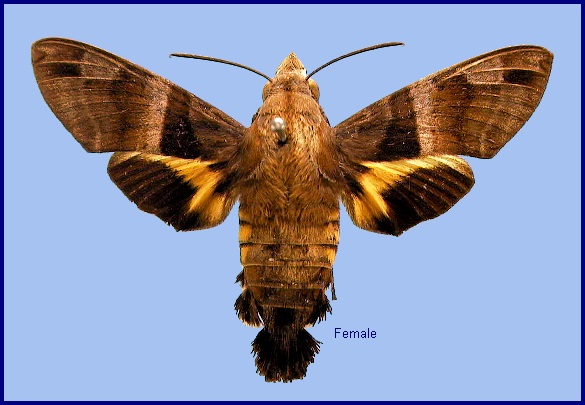
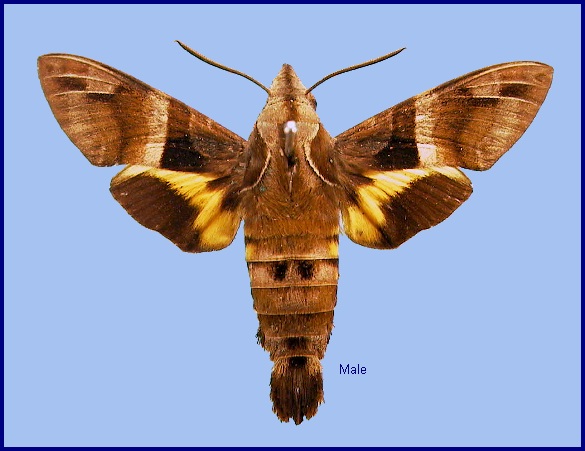
Macroglossa heliophila Boisduval, [1875], in Boisduval & Guenée, Hist. nat. Insectes (Spec. gén. Lépid. Hétérocères) 1: 354. Type locality: [Indonesia: Maluku,] Halmeira [Halmahera].
Synonym. Macroglossa fringilla Boisduval, [1875], in Boisduval & Guenée, Hist. nat. Insectes (Spec. gén. Lépid. Hétérocères) 1: 352. Type locality: [India].
Synonym. Macroglossa kanita Swinhoe, 1892.
Synonym. Macroglossa loochooana Rothschild, 1894.
[Further details on this species in Japan, as well as photos of many stages, can be found on Digital Moths of Japan under Macroglossum heliophilum.]
Wingspan: 50--60mm. Forewing upperside with the space between the two antemedian lines filled to form a very prominent band that is nearly straight distally and dilated basad at hind margin; first and second discal lines curved costad anteriorly, concave between vein M1 and hind margin, the space between not completely filled, the lines remaining distinct: first thin, second heavier, dilated behind vein M1 to reach the postdiscal line as a prominent spot, the vein here grey, bordering a well-defined postdiscal costal grey patch. A prominent subapical spot behind vein Rs4, with the space between veins Rs3 and Rs4 grey. Both wings undersides dull burnt-umber-brown, the bases shaded with yellowish buff. Forewing underside with central area darker, the discal border duller, darker brown. Hindwing upperside black border convex, more-or-less angled near vein Cu1. Hindwing underside yellow anal area well-defined, reaching about 1.5 mm short of the tip of vein 2A.
Head and thorax upperside with prominent dark mesial stripe. Mesothoracic tegula with a well-marked dark triangular area. Abdomen upperside with a pair of prominent black dorsal spots on fourth tergite; side tufts all white-tipped. Underside of palpus, middle of thorax, and a mesial patch on basal abdominal sternites greyish white; remainder of abdomen dull burnt-umber-brown; tail darker.
In the male genitalia, uncus broad, rounded-truncate, flattened apically. Gnathos spatulate, upperside elevated mesially, the apical margin tapered. Valve with stridulatory scales. Harpe swollen distally, obtuse, often with a subapical, lateral, tuberculated hump. Phallus very similar to that of Macroglossum melas, but the teeth near the base of the process larger.
Distinguished from Macroglossum sitiene and Macroglossum variegatum by the white underside of the palpus and thorax, and from Macroglossum melas by the body and wings being less black.
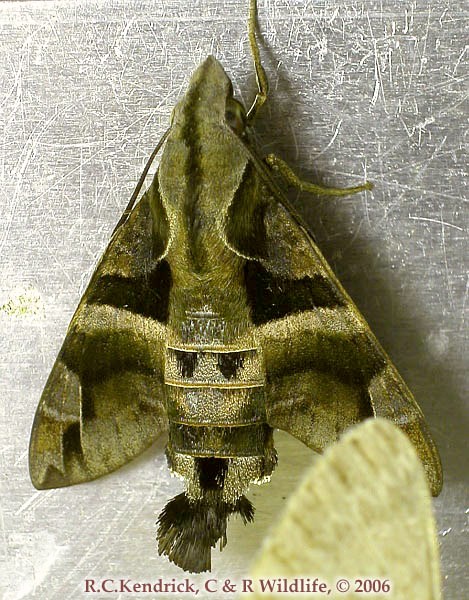
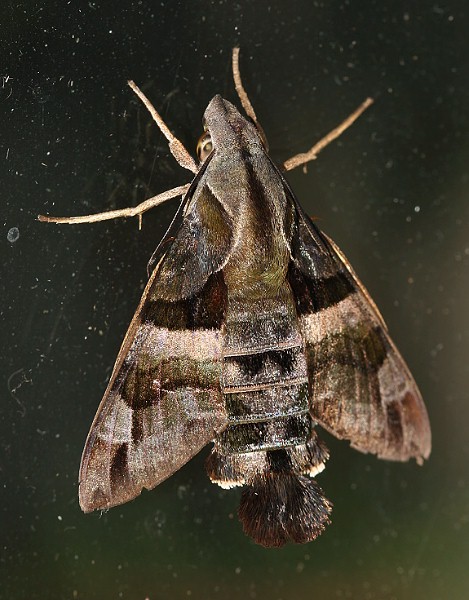
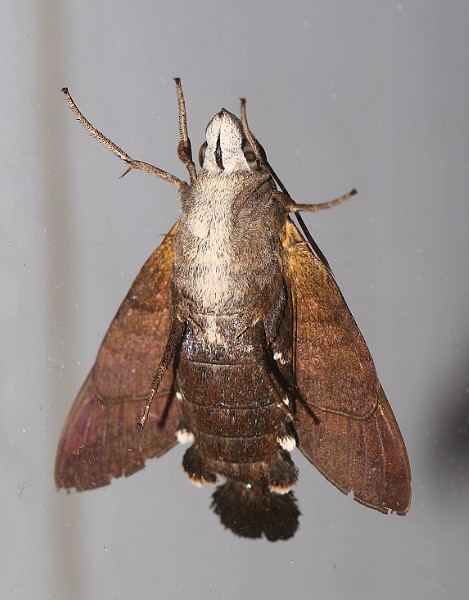
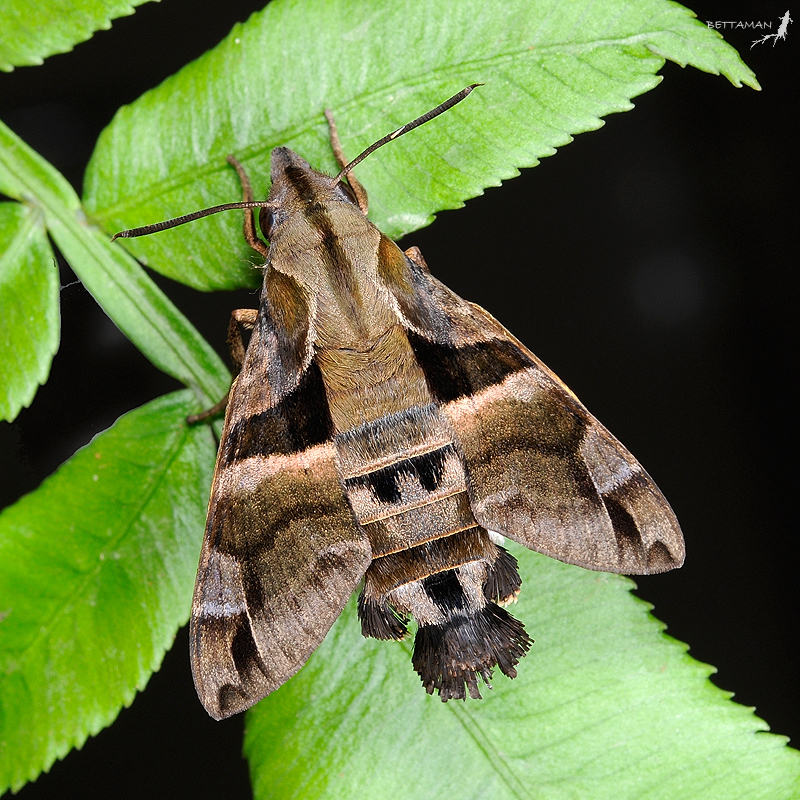
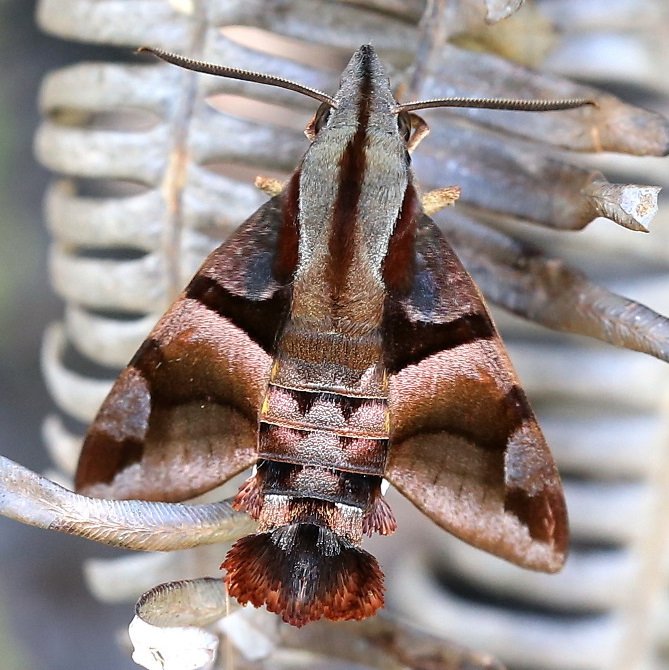
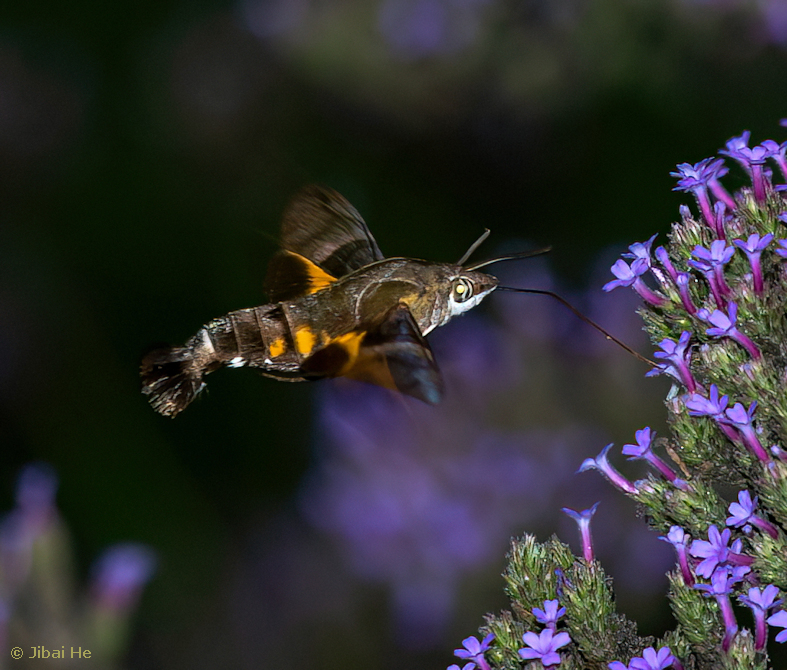
The moths may be seen feeding during the afternoon, but do not appear to be attracted by light (Bell & Scott, 1937).
China: iv (Hong Kong); vi-vii (Hainan; Hong Kong; Zhejiang); 1.viii (Zhejiang); ix-x (Hong Kong); x (??Fauling; Guangdong; Hainan); xi-xii (Hong Kong). Taiwan: vii (Tainan Hsien); ix (Kaohsiung). Japan: 12.ix (Ishigaki-jima, Ryukyu Archipelago); 22.xii (Ryukyu Archipelago).
Kendrick (2002) states that it is multivoltine in Hong Kong, occurring in April and from June until December.
OVUM: Pale yellow, nearly spherical (1.5 x 1.4 mm.), surface smooth and shiny (Bell & Scott, 1937).
LARVA: Full-fed 70mm, width 10mm, horn 13 mm. According to Bell & Scott (1937), in the first instar horn long, straight, bifid, and shiny black. Head, segment 2 and anal segments behind base of horn honey-yellow, rest of body blood-red. In the second instar, head yellowish, segment 2 and anal segments pale yellow; rest of body dark maroon-red; horn shiny black. This colour scheme persists into the third instar, but is paler. The body is dotted with white and there is a dark dorsal stripe and a narrow whitish spiracular stripe. By the fourth instar the horn has become very long. The head is opaque pale green; body translucent pale green, dorsum suffused with yellow and in some cases with touches of maroon-red, the whole dotted with white. There is a dull olive-green dorsal stripe. The horn with basal half shiny black, distal half green with black tip, the whole covered with black tubercles. Legs shiny black, prolegs with a shiny black band.
In the fifth instar, head round. Clypeus with apex acute, not quite one-half length of head; false clypeus with apex acute, reaching a little more than one-half length of head; labrum one-half length of clypeus; ligula as long as labrum but narrower, kidney-shaped; cutting-edge of mandible strongly toothed. Surface of head dull, covered with minute bubble-like tubercles. Body of the usual Macroglossine shape; dull and smooth except for minute tubercles on the secondary rings of segments 12 and 14. Horn very long, thin, tapering evenly to a fine point, distal half slightly up-curved; shiny and covered with small conical tubercles (Bell & Scott, 1937).
There are two main colour forms. In the green form, head yellowish-green; labrum glassy-green; ligula glassy yellowish-green; basal segment of antenna green, other segments red; mandible green, tip broadly dark reddish-brown; eyes brownish. Body pale grass-green, with a row of yellow or whitish dots encircling each secondary ring. The dorsal stripe is limited to a line of triangular markings, dark green or violet, at the front margin of segments 6 to 11. Horn in many with basal two-thirds pale purple, distal third greenish-yellow, tip orange; however, in many the entire horn may be orange-red. True legs with basal segment shiny black, remaining segments rose-colour. Prolegs with base green, shank shiny yellow with a broad black band, ankle maroon-rose, foot dirty white; clasper with front half green, hind half bluish; venter yellowish on segments 2 to 4, rest green. Spiracles oval, flush, white with a very broad rusty-orange: band across the middle (Bell & Scott, 1937).
In the dark-coloured form the head is pale brown; labrum green; ligula brownish-green. Body dark smoky olive-green or olive-brown, dotted with white. There is a saddle-shaped marking on segment 2 of soiled ochreous-brown, covered with small white tubercles. A bluish-black dorsal stripe is present, which is black and widening at the front margins of 6 to 11. Horn reddish-brown at base, then olive-green, then reddish-brown again, tip and tubercles black. True legs with basal segment black, other segments blood-red or brownish-red. Prolegs with shanks orange with broad black band, ankles pale yellow, feet livid white. Distal two-thirds of anal flap and clasper faces soiled ochreous-brown, the clasper shank brown with a broad black band. On the venter of segments 6 to 11 there is a transverse row of enamel-white dots around the anterior secondary ring of each segment. Spiracles white with a broad, dark, reddish. brown band across the middle (Bell & Scott, 1937).
The long horn is moved freely in a vertical plane in all instars.
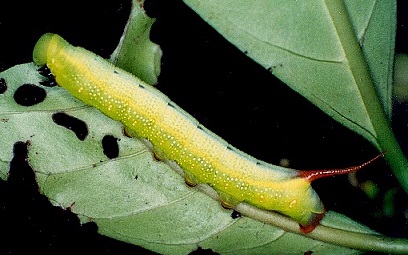
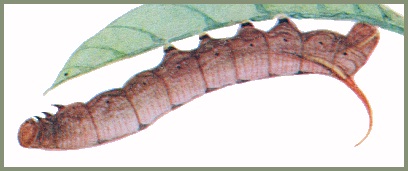
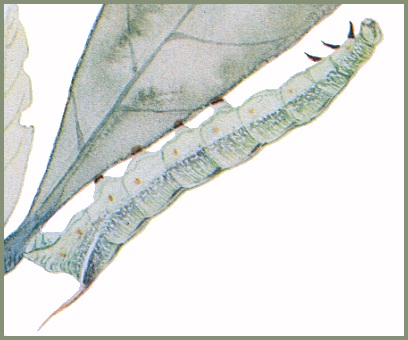

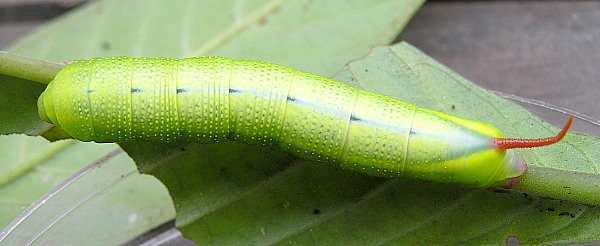
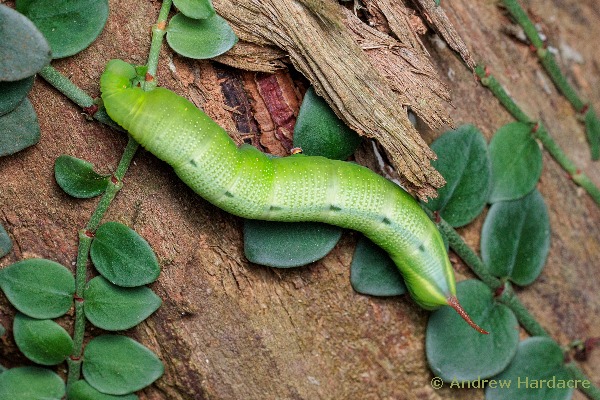
PUPA: 40mm, width 11.5 mm. Generally of a pinkish bone-colour, but head, thorax and wing-case tinged with green; tongue with a narrow black median line not continued on to sheath. Tongue, legs, antenna and wing-case marked with narrow transverse bands of olive green. There is a black patch on the frons, and a black dorsal stripe on thorax, which is also dotted with black. An obscure fuscous lateral stripe is present on the abdomen, with a large black spot at lower end of hind bevel of segment 8. Front bevel of 9 dark rusty; pits of abdomen rusty; spiracles black, lying in small black patches; cremaster rusty, with lateral edges of base olive-green (Bell & Scott, 1937).
Shape as in others of the genus. Tongue-case short; the hind margin of segment 11 somewhat tumid, 12 fitting in to it telescopically. Tip of tongue spatulate; antenna slightly longer than fore leg and reaching to middle of wing-case, mid-leg to about two-thirds; a very narrow coxal piece is present. Surface moderately shiny; tongue-case dorsally shallowly channelled; head, thorax and wing-case smooth; abdomen coarsely vermiculate-corrugate and pitted, segment 9 with a very prominent ante-spiracular ridge, the front bevel coarsely tuberculate and with a deep transverse channel at its base; less prominent ridges on 10 and 11. Spiracle of 2 with the slit bordered in front by the curved, emarginate, slightly tumid hind margin of 2, and behind by an oblong transverse lobe projecting from the front margin of 3; other spiracles oval, surface rising gently to the narrow rim of the central slit. Cremaster nearly oblong, narrowing slightly distad, end widely curved-emarginate; with a short, sharp tooth, directed distad, at each lateral angle. In some specimens there is a smaller tooth on the inner side of the base of this tooth, and two or three small teeth along outer edge of distal third of cremaster. Upper surface smooth and shiny, lower surface with a central keel and a broad channel on each side of the keel (Bell & Scott, 1937).
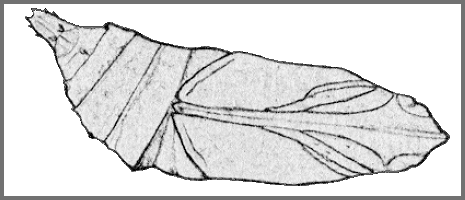
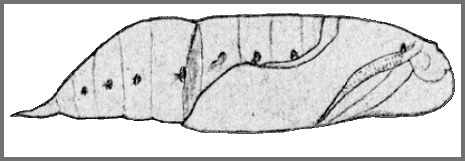
Larval hostplants. Psychotria rubra (Rubiaceae) in Hong Kong (Li, pers. comm. 2002), Macau (Easton & Pun, 1996) and Taiwan (ShiPher Wu, pers. comm. 2012), and Psychotria dalzellii in India (Bell & Scott, 1937). Also recently recorded from Creeping Psychotria (Psychotria serpens L.) in Hong Kong (Andrew Hardacre, pers. obs. 2023), a small-leaved, ivy-like plant which is easily mistaken for the very similar Creeping Fig (Ficus pumila) as it snakes its way up tree trunks and along branches.
Unknown.
China: Zhejiang (Nanji Islands National Nature Reserve, Wenzhou); Hunan; Fujian (Luoyuan); Guangdong; Macau; Hong Kong (Kowloon); Hainan (??Youboi; Chengmai; Haikou); ??Fauling.
Taiwan: Tainan Hsien (Kuantzuling, 1000'); Kaohsiung; Taipei (Mt. Elephant; Neihu); Taipei Hsien (Fushan); Hualien Hsien (Hungyeh; Changliang-Li).
South Korea: Cheju Province (Cheju-do). (Park et al., (1999) consider the single record to be that of a vagrant. It has not been seen in Korea since then.)
Japan: Ryukyu Archipelago (Okinawa (Kishida & Shirakawa, 1988); Iriomote-jima; Ishigaki-jima) (Tanahara, 1998b); Ogasawara/Bonin Islands (Takeuchi & Ohbayashi, 2006).
Found from northeastern India (Sikkim) across southern China to Cheju Island (South Korea), southern Japan, Taiwan and the Philippines. Then south through Vietnam (Le & Vu, 2024), Thailand, Malaysia and Indonesia to New Guinea and neighbouring islands. A recent colonist of the Ogasawara/Bonin Islands (Takeuchi & Ohbayashi, 2006).
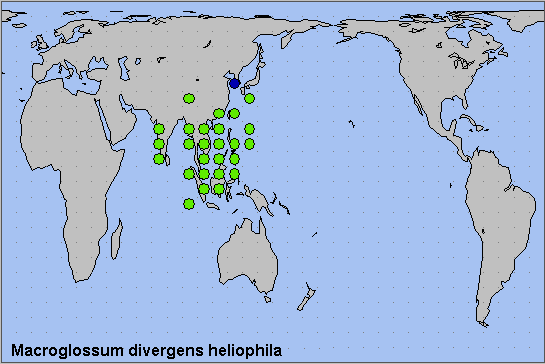
 Return to Sphingidae of the Eastern Palaearctic species list
Return to Sphingidae of the Eastern Palaearctic species list